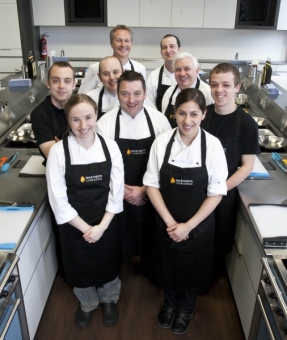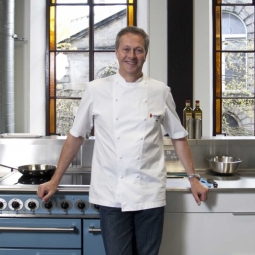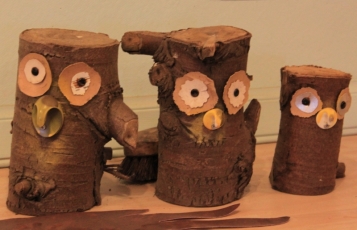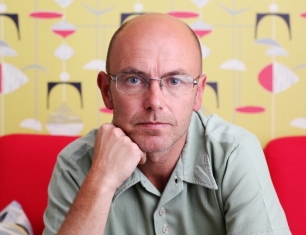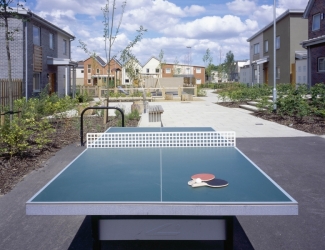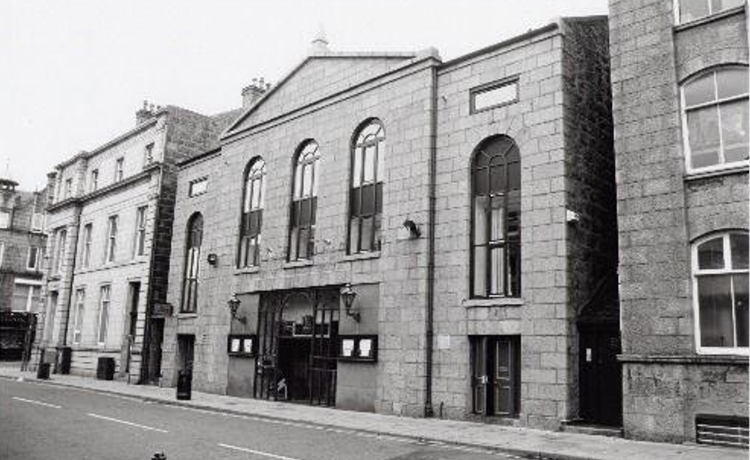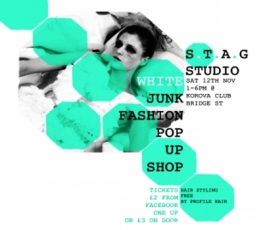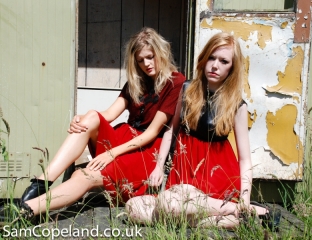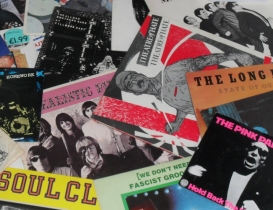Voice’s Suzanne Kelly was present to witness Wayne Hemingway give a talk to a full house at Robert Gordon’s Business School on the evening of 5th October. The audience was a wide mix of students, lecturers, design practitioners, businesspeople and others (Hemingway kept asking the audience questions to determine who was there, and he tailored his presentation accordingly).
Mr Hemingway gave an illuminating, bespoke talk. My only criticisms were that the lighting engineer had no clue what type of lighting was appropriate for a slide/video presentation talk where people wanted to take notes (the lights went on and off, up and down for most of the second half), and that those who plan to forever change Union Terrace Gardens weren’t in evidence.
They might have learnt something.
If you think the Hemingway family (Wayne and Gerardine) are associated solely with fashion and the iconic ‘Red or Dead’ brand, you are missing some very important developments – housing developments to be precise.
Wayne saw a very clear need (which alas many planners and construction firms miss) to create places where people would actually want to live, socialise, landscape, play and be proud of. But more on that later.
Hemingway began the talk with his own life and design history.
In his early family years in Blackburn, his family was not wealthy; they valued creativity and imagination. He was on the music and clubbing scene from age 13 or so, and was enthralled by all he saw and heard in these early heady days of punk. He met his future wife and business partner Gerardine in a club, and was impressed with her clear passion and talent for clothes and customising vintage wear.
They got engaged, headed to London, and did typical day jobs (she as a secretary; he in a pub). One month things looked tight for paying the rent, so they decided on the entrepreneurial path and took a stall in Camden Market to sell their own second-hand, vintage clothing. This first outing proved so successful (and I assume enjoyable) that they put their efforts towards buying second hand clothing to sell. They delved into the world of ‘the rag trade’ literally – buying goods otherwise destined for recycling from the ‘shoddy’ yards.
Few were touching vintage or second hand at the time, and the popularity of their stall grew and grew.
They soon learnt marketing tips such as the importance of where the stall was located in Camden. The now iconic Doc Marten boot was adored by the punk world, but elsewhere just seen as workers’ footwear. A clever deal with Doc Marten saw the duo buying old, damaged DMs in quantity (where the soles were worn through), repairing them (with a family member’s repair solution and friends to help), and selling them on for a considerable profit. The business grew and grew.
Gerardine created a small line of clothing – there were only eight pieces in the whole line – and headed to the very cool Kensington Market to join other designers and artists selling work. Of all things Macy’s of New York found her there, and placed an order for 200 of each item. With some help from several friends and relatives who could sew they were able to fill the order. Out of this growth and interest, ‘Red or Dead’ came to life.
Wayne had bought a large number of non-working sample watches; these were used to decorate shoes.
An older man in the trade asked Wayne ‘What does Red or Dead stand for?’ In the ensuing conversation this man explained how different brands were clearly aligned to aspirations and values: Weetabix, Nike, etc. – all major brands had a ‘raison d’etre’. Wayne and Gerardine made a list of things they stood for themselves – they were politically active, they came from areas without expensive, fashionable designer wear, they valued creativity and bought affordable items themselves.
It was clear they wanted Red or Dead to be affordable designer clothes. In deciding this they reached out to a sector of the public which had long been ignored. (They also realised that Macy’s did not fit with this direction).
The Red or Dead lines were to be sold through Top Shop (1983) and Miss Selfridge. Topshop at that point used to have no designers – only buyers and “copiers”. These days it uses established and graduate designers, and the flagship London store also has a vintage section, perhaps a nod to ‘Red or Dead’.
At this time the pair had started paying attention to London Fashion Week, which was still at the time primarily an affair for the affluent. But the ‘powers that be’ at London Fashion Week had noted Red or Dead’s ascent with disdain.
The Hemingway’s dealings with Topshop and Miss Selfridge actually prevented them from showing at London Fashion week for there years. The Hemingways had ‘demeaned’ fashion, and fashion ‘is about Harrods and Harvey Nicols.’ Or at least this was true to a Fashion Week mandarin.
This rebuff did not hurt Red or Dead sales in the least.
One year when the French were conducting nuclear tests and protestors were demonstrating against the tests around the world, London Fashion Week saw some drama courtesy of Red or Dead. “Non a Nuclear” banners provided the backdrop to the Read or Dead collection and French buyers were banned from the RoD show (which accounted for about a quarter of the buying audience normally – this exclusion was a considerable financial gamble).
Wayne explained he and Gerardine were willing to lose this custom in favour of making a political statement and appealing to and showing solidarity with the environmentalists – a growing movement in terms of visibility and economic power. What was going to be the public, media and market reaction to this show? The Hemingways went home.
Watching the national news some hours later, an item opened with a protest outside the French Embassy at Trafalgar Square.
Then the news item cut directly to the Red or Dead Fashion show.
All the media had picked up the story – and the phone started ringing. Wayne and Gerardine were being summoned that same night to talk to the press – the story of their show had veritably gone global.
Sales increased some 400% around the Red or Dead shops (which by now were in many countries). Corporate takeover advances soon came, and the Hemingways decided to sell. It was time for another adventure.
Wayne had interspersed this biographical talk with some sage business advice – the willingness to take risks, the way in which he delved deeply into the workings of the fashion industry from the lowly shoddy yards to the high end and London Fashion Week; all of which contributed learning experiences leading to success. (And by the way, apparently he is a very early riser, proving there must be some truth in the old ‘early to bed, early to rise…’ adage).
Wayne tells the audience:
“You learn absolutely every day; you need an ability to graft; there is never a day I get up after 5am.
“Creative minds don’t switch off… it’s how you get those ideas realised – graft and recognising which ideas can work… you need friends and good minds behind you.”
He also said without any false, unnecessary modesty how good he and Gerardine were at putting excellent teams together.
Turning from fashion to architecture and housing was the new direction. Boris Johnson had asked Wayne to be a ‘London Leader’, which involved working with the Mayor on a voluntary basis on projects and ideas to make London better. At this point the talk turns from fashion history to the future of our cities.
“We’ve allowed our High Streets to become ‘clone’ High Streets.” Hemingway says, and no one can argue with that.
He discusses his contribution to Boris Johnson’s project, which was ‘KiosKiosk’ – moveable, affordable (need I say it – well-designed) designer boutiques on wheels, seen at various London icons such as the Wheel. These offer young designers a chance to meet the world head on – and since a stall at Camden Market is now extremely expensive, this offers others the kind of break the Hemingways had at the start.
Hemingway also applauds the model of ‘pop-up’ shops and restaurants, which have taken London by storm, and which have reached Aberdeen (for instance Emma Noble’s and Toni Roddie’s S.T.A.G Studio events at Korova – 19 November).
Hemingway references an article he wrote, “Why I Hate The Creeping Suburbs” in which he describes the Wimpeyfication and ‘Barratification’ of Britain.
The issues surrounding ‘urban sprawl’ are now recognised by the United Nations (as well as by most serious, thoughtful local planners); our ecology and biodiversity are not all that is at stake – our very health is jeopardised by the cities and suburbs over spilling into the countryside (increasing asthma and heart problems come with increased pollution; obesity from lack of exercise as we all commute to and from the cities to work, alcoholism increases, and so do social problems).
As a designer who has identified a problem does, Wayne decided to ‘look inside’ the issue, ‘see what he already knew’ about housing, and propose solutions.
He showed poignant photos at this point – a fairly new housing development which clearly looked more like a prison or factory; a beautiful Victorian pub turned into a block of (very unattractive, compact) flats, and a Liverpool street which once offered small, good first homes, now earmarked for high-rise flats.
He cautioned that mortgage companies (which could have provided mortgages for people to fix and modernise the existing homes on that Liverpool street) are dictating the state of our housing by what they will lend money for. They seem to favour mortgages for new properties and turn down those who want to refurbish and improve properties.
The old Victorian homes may leak carbon, but they have been around for one hundred years, and thus have less of a carbon footprint than the alternative of tearing them down to make flats.
Wayne has designed housing estates which have very few, if any, equals in the UK.
There are leisure spaces for families (sand, trees, tables, different levels, etc. – some of the best design work he ever did, he tells us), and community gardens. No one vandalises these (or the outdoor communal Ping-Pong table) because everyone’s families had a hand in creating and designing them in the first place. The design for these estates started with people first and what they wanted and liked – the actual housing came second to the people.
Wayne ends with some great footage of his and Gerardine’s ‘Museum of Lost Content’ (a home for vintage design which might otherwise be forgotten) and the Vintage event – a massive ‘happening’ (for lack of a better word) held last year at London’s Southbank.
This festival combines decades of design and fashion, iconic music, bands, events and everything that celebrates Britain you can imagine in one place. It was attended by thousands. As words fail me, I suggest you visit http://www.vintagebyhemingway.co.uk/ and let the design do the talking.
Wayne also discussed photos he has of an Aberdeen estate; there are signs prohibiting virtually every kind of activity a child (or adult) might want to indulge in, including the dreaded ‘ball-playing.’
Question time arrives, and I am dying to ask for a comment on the future of our Union Terrace Gardens then and there. However I decide that once the designs are unveiled, I will contact Hemingway. I have no doubt he will have something useful to say after tonight’s talk. It was a valuable and thought-provoking evening, and I was glad for this glimpse into ‘Wayne’s World.’
